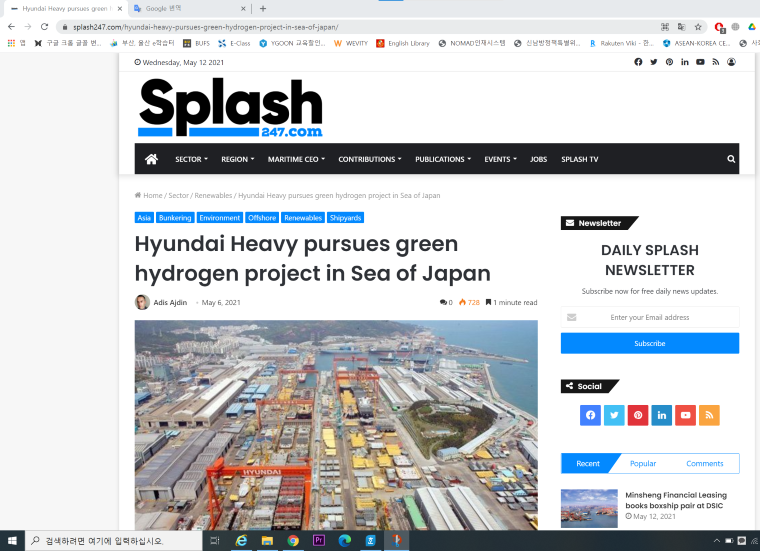 작성일 : 21-05-12 21:39
작성일 : 21-05-12 21:39
|
https://splash247.com/hyundai-heavy-pursues-green-hydrogen-project-in-sea-of-japan/
|
 |
|
| 서한 |
시정서한 |
|
| 매체 |
웹사이트
|
|
| 이슈 |
동해
|
|
| 언어 |
영어
|
|
| 서한보내는곳 |
splash247.com |
|
| 오류내용 |
동해를 일본해로 표기 |
|
| E-mail / Contact |
sam@asiashippingmedia.com |
|
서론 |

We wish you endless prosperity. Hi. I am “Noh seowon”, a high school student who is active in protecting “Dokdo” and “East Sea” in Korea. I am working to protect our territory and territorial waters from Japan and to be recognized by the international community. I am sending an e-mail because I found a part of your website where “East Sea” was incorrectly marked as “Sea of Japan”, explaining its historical background and asking for the correct notation in articles after this time.
|
|
| 본론 |
‘East Sea’ is a name that has been used by Koreans for over 2,000 years, and this can be confirmed in various historical sources and old maps. As Japan emerged as a powerhouse in Asia at the end of the 19th and early 20th centuries, when world maps that looked almost the same as today were produced in earnest, the'East Sea' waters began to be widely known as the'Sea of Japan'. . In particular, when the International Hydrographic Organization (IHO) published the first edition of “Limits of Oceans and Seas” in 1929, Korea was given an opportunity to assert the validity of the East Sea name to the international community under Japanese colonial rule. What it did not have was the reason for accelerating the international spread of the'Sea of Japan' mark. This booklet “Boundary of Oceans and Seas” was a book that was recorded by determining geographical names at the level of international organizations, and became an important citation for the borders and names of the world's oceans. At the time of publication of the second edition of this book (1937), Korea is still It was under Japanese colonial rule, and at the time of publication of the third edition (1953), it was during the Korean War. In rebuilding the country after the Korean War, we have been striving to properly reflect the'East Sea' mark. For example, at the time of the conclusion of the 「Korea-Japan Fisheries Agreement」 in 1965, the two countries could not agree on the name of the sea area, and eventually decided to use'East Sea' and'Sea of Japan' separately in their own language version of the agreement. Various activities have been continuously promoted to recover the nomination. Thanks to these efforts, the government officially raised the East Sea marking issue at an international conference for the first time at the 1992 United Nations Conference on Geographical Names Standardization after Korea's accession to the United Nations in 1991.
|
|
| 결론 |
'East Sea' has been used for more than 2,000 years, and is still used by 75 million Korean people, and has an important meaning to us as it appears in the first verse of the national anthem. Nevertheless, unlike Japan, we do not insist on the use of ‘East Sea’ alone instead of ‘Japan Sea’, and we are presenting a rational way of stating the names used by both sides together. Therefore, the'Japan Sea' displayed on your website should be written as'East Sea' or'East Sea (Japan Sea)'. Please correct the incorrect notation in this article, and make an effort to make it correct when writing future articles. We look forward to your response. Wishing you endless prosperity...Noh Seowon |
|

